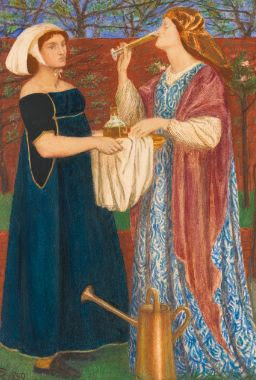This watercolour is in the medievalising style of Rossetti's earlier works. It is one of a series of similar subjects that Rossetti painted for William Morris. Rossetti described the picture simply as 'some people playing music' (Doughty & Wahl I, p.376), but it may have been loosely inspired by Tennyson's Morte d'Arthur and possibly also Villon's Ballad of Dead Ladies, which Rossetti translated. Morris was so intrigued by The Blue Closet that in 1856, a year before the date inscribed on the watercolour, he wrote a poem based on its enigmatic subject matter:
Alice the Queen and Louise the Queen,
Two damozels wearing purple and green
Four lone ladies dwelling here
From day to day and year to year
Morris's interpretation is purely subjective, and Rossetti commented that, 'though beautiful in themselves,' his poems 'were the result of the pictures, but don't at all tally to any purpose with them.'(G.S. Layard, Tennyson and his Pre-Raphaelite Illustrators, 1894, p.55.)
The four women in medieval dress are playing a curious hybrid musical instrument and singing from sheets of music. They stand in a room lined with blue tiles. Frederic Stephens, a member of the Pre-Raphaelite Brotherhood, later commented on the correspondence between colours and sounds: 'The sharp accents of the scarlet and green seem to go with the sound of the bell', while 'the softer crimson, purple and white accord with the throbbing notes of the lute and clavichord, while the dulcet, flute-like voices of the girls appear to agree with those azure tiles on the wall and floor' (quoted in Marsh 1999, p.171).
The symmetrical grouping of the figures recalls the composition of medieval scenes of angels making music (such as Orcagna's panel of Musical Angels in Christ Church Oxford). The sprigs of holly lying across the top of the instrument may be intended to denote the time of year. They are balanced by the red-orange lily at the foot of the picture, which Morris's poem links with death. Various enigmatic devices on the side of the instrument remain too esoteric to interpret, but the symbol of the sun and moon is frequently used by Rossetti to suggest the passage of time.
Further reading:Oswald Doughty and J.R. Wahl (eds), Letters of Dante Gabriel Rossetti, 4 vols., Oxford 1965-7.
Leslie Parris (ed.), The Pre-Raphaelites, exhibition catalogue, Tate Gallery, London 1984, reprinted 1994, p.280, reproduced p.280, in colour.
Elizabeth Prettejohn, The Art of the Pre-Raphaelites, London 2000, p.119, reproduced p.118, in colour.
Virginia Surtees, The Paintings and Drawings of Dante Gabriel Rossetti (1828-1882) - A Catalogue Raisonné, 2 vols., Oxford 1971, p.50, no.90, reproduced pl.115.
Frances Fowle












































